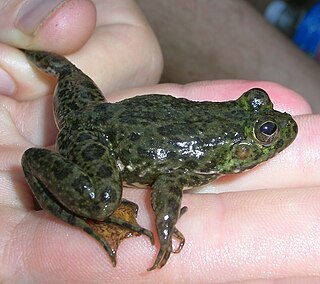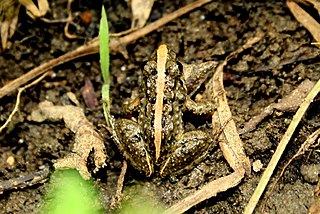
Microhyla sholigari is a species of microhylid frog endemic to southern India. It was described from the Biligirirangan Hills in Chamarajanagar district, Karnataka and is named after the Soliga tribal people living in the forests in and around these hills. The frog was thought to be endemic to the Western Ghats and known only from the type locality and another location in Kerala and was listed as an Endangered species. A recent study reported the species from 15 localities in the central Western Ghats with individuals sighted near the Bannerghatta National Park, Bangalore, Karnataka. The study supplemented the original species description with color photographs, call recordings and provided a re-assessment of the threat status as per the IUCN Red List and suggest the status as Least-concern species because the criteria for classifying it as an endangered species are no longer fulfilled.

Euphlyctis is a genus of frogs in family Dicroglossidae distributed from the southwestern Arabian Peninsula, Pakistan and Afghanistan to India, Nepal, through Myanmar and Thailand to Malaya, and Sri Lanka. None of the four species assessed by the IUCN is considered threatened.

Fejervarya is a genera of frogs in the family Dicroglossidae found in Asia. First proposed in 1915 by István József Bolkay, a Hungarian naturalist, the genus did not see widespread adoption at first. As late as the 1990s it was generally included in Rana, but more recent studies have confirmed its distinctness.

Euphlyctis hexadactylus, also known as the green pond frog, Indian green frog, and Indian five-fingered frog, is a common species of aquatic frog found in Pakistan, India, Bangladesh, and Sri Lanka. The nominal taxon likely represents a species complex.
Scinax danae is a species of frog in the family Hylidae. It is endemic to southeastern Venezuela and occurs in the La Escalera region of the Sierra de Lema, Bolívar state. The specific name danae honors Dana Trueb Duellman, the daughter William E. Duellman, the scientist who described this species. Despite this, common name Bolivar snouted treefrog has been coined for this species.
Scinax exiguus is a species of frog in the family Hylidae. It is found in the Gran Sabana of Venezuela and in the Roraima state of the adjacent northern Brazil, as far south as Boa Vista, Roraima. Common name Gran Sabana snouted treefrog has been coined for it.
Pristimantis variabilis is a species of frog in the family Strabomantidae. It is found in the lowland Amazon rainforest and Andean slopes in southern Colombia, eastern Ecuador, eastern Peru, and western Brazil. The specific name variabilis refers to the variable dorsal coloration of this frog. Common name variable robber frog has been proposed for it.
Phrynopus dagmarae is a species of frog in the family Strabomantidae. It is endemic to the Andes of Peru and only known from the Pachitea and Ambo Provinces in the Huánuco Region, from near the type locality. The specific name dagmarae honors Dagmar Schramm from Germany.

Lynchius flavomaculatus, also known as the yellow-spotted Andes frog, is a species of frog in the family Strabomantidae. It is found in the Andes of southern Ecuador and northern Peru.

Minervarya sahyadris, also known as the small cricket frog, is a species of frog in the family Dicroglossidae. It is endemic to central Western Ghats of kerala& Karnataka in India.
Cornufer macrosceles is a species of frog in the family Ceratobatrachidae. It is endemic to the island of New Britain, Papua New Guinea. It is only known from the Nakanai Mountains in the central part of the island. Only three specimens are known. Common name Ti wrinkled ground frog has been coined for the species.
Minervarya charlesdarwini is a species of frogs in the family Dicroglossidae. It is endemic to the Andaman Islands, India, and is known from the South Andaman Island, Long Island, and North Andaman Island.

Raorchestes tuberohumerus is a species of frog in the family Rhacophoridae. It is endemic to the Western Ghats, India, where it is found in Karnataka and Kerala states.
Phrynopus tribulosus is a species of frog in the family Strabomantidae. It is endemic to Peru and only known from its type locality near Oxapampa at 2,600 m (8,500 ft) asl, and from Santa Bárbara, in the Huancabamba District, Oxapampa, Pasco Region. It inhabits humid montane forests where individuals could be found deep within a mossy bank by day.

Minervarya nilagirica, commonly known as Nilgiris wart frog, or Nilgiris frog, is a species of frog that is endemic to India.

Minervarya kudremukhensis is a species of frogs in the family Dicroglossidae. It is endemic to the central Western Ghats of Karnataka state, India. The name kudremukhensis refers to the type locality, Kudremukh.
Limnonectes lauhachindai, also known as Lauhachinda's fanged frog, is a species of frog in the family Dicroglossidae. As currently known, it is endemic to Ubon Ratchathani Province, Thailand, where it has been recorded from Na Chaluai and Sirindhorn Districts. However, its true range is expected to be wider, also extending into adjacent Laos and Cambodia. It is the sister taxon of Limnonectes dabanus and Limnonectes gyldenstolpei. It is one of the five caruncle-bearing Limnonectes species.
Limnonectes nguyenorum is a species of fanged frog in the family Dicroglossidae. It is endemic to northern Vietnam and only known from the area of its type locality in Vi Xuyen District, northwestern Ha Giang Province, northern Vietnam. It is part of the Limnonectes kuhlii species complex.

Euphlyctis karaavali is a species of frog in the family Dicroglossidae. It is endemic to the southwestern coast of India in Karnataka.

Minervarya agricola is a species of frog that is native to Indian subcontinent. Earlier identified as M. granosa and Zakerana syhadrensis due to large distribution, the species was classified as a separate species in 2019.













